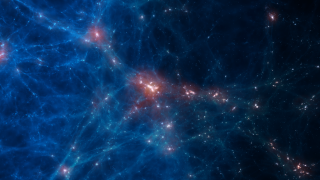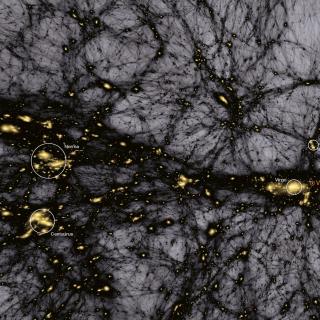Bibcode
Cullen, F.; McLure, R. J.; Khochfar, S.; Dunlop, J. S.; Dalla Vecchia, C.
Referencia bibliográfica
Monthly Notices of the Royal Astronomical Society, Volume 470, Issue 3, p.3006-3026
Fecha de publicación:
9
2017
Número de citas
81
Número de citas referidas
77
Descripción
We present the results of a study investigating the dust attenuation law
at z ≃ 5, based on synthetic spectral energy distributions (SEDs)
calculated for a sample of N = 498 galaxies drawn from the First Billion
Years (FiBY) simulation project. The simulated galaxies at z ≃ 5,
which have M1500 ≤ -18.0 and 7.5 ≤ log(M/M}_{⊙})
≤ 10.2, display a mass-dependent α-enhancement, with a median
value of [α /{Fe}]_{z=5} ˜eq 4 × [α
/{Fe}]_{Z_{⊙}}. The median Fe/H ratio of the simulated galaxies is
0.14 ± 0.05 which produces steep intrinsic ultraviolet (UV)
continuum slopes; 〈βi〉 = -2.4 ±
0.05. Using a set of simple dust attenuation models, in which the
wavelength-dependent attenuation is assumed to be of the form
A(λ) ∝ λn, we explore the parameter values
which best reproduce the observed z = 5 luminosity function (LF) and
colour-magnitude relation (CMR). We find that a simple model in which
the absolute UV attenuation is a linearly increasing function of log
stellar mass (A1500 = 0.5 × log(M/M⊙) -
3.3), and the dust attenuation slope (n) is within the range -0.7 ≤ n
≤ -0.3, can successfully reproduce the LF and CMR over a wide range
of stellar population synthesis model assumptions, including the effects
of massive binaries. This range of attenuation curves is consistent with
a power-law fit to the Calzetti attenuation law in the UV (n = -0.55).
In contrast, curves as steep as the Small Magellanic Cloud extinction
curve (n = -1.24) are formally ruled out. Finally, we show that our
models are consistent with recent 1.3 mm Atacama Large Millimeter Array
observations of the Hubble Ultra Deep Field, and predict the form of the
z ≃ 5 infrared excess (IRX)-β relation.
Proyectos relacionados

Astrofísica Numérica: Formación y Evolución de Galaxias
Entre las cuestiones fundamentales en Astronomía y Astrofísica están la formación y evolución de galaxias. Las escalas de tiempo y tamaño son tan astronómicas que su observación en galaxias individuales es imposible. Solo con el uso de simulaciones numéricas es posible entender la formación de estructuras cósmicas dentro del actual marco
Claudio
Dalla Vecchia

Cosmología con Trazadores de la Estructura a Gran Escala del Universo
El Fondo Cósmico de Microondas (FCM) contiene la información estadística de las semillas primigenias que han dado lugar a la formación de todas las estructuras en el Universo. Su contrapartida natural en el Universo local es la distribución de las galaxias que surgen como resultado del crecimiento gravitatorio de aquellas fluctuaciones de densidad
FRANCISCO SHU
KITAURA JOYANES